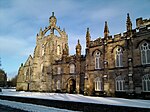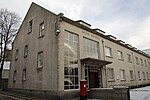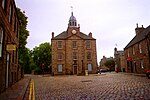Christ's College, Aberdeen
Christ's College, Aberdeen was one of three colleges in Scotland founded by the Free Church of Scotland for the training of ministers following the Disruption of 1843. The other two were New College, Edinburgh and Trinity College, Glasgow. Following the Church reunion of 1929, Christ's College became a Church of Scotland college and was also integrated into the University of Aberdeen. It now is based within the University's King's College campus in Old Aberdeen. The College's former buildings in the west end of Aberdeen are no longer used by the church or university. The post of Master of Christ's College is still a Church of Scotland appointment, but for most purposes it is closely connected with the University of Aberdeen's School of Divinity, History and Philosophy. The current Master is the Rev. Professor John Swinton; who followed on from Rev Ian Dick Minister at Ferryhill Parish Church and the first full time Parish Minister to be appointed Master. The principal role of Christ's College is to oversee the preparation and formation of ministerial candidates for the Church of Scotland. From its offices in the University of Aberdeen, the College collaborates closely with the divinity faculty to ensure candidates receive appropriate academic training for the ministry, funding a lectureship in Practical Theology, organizing extramural lectures and seminars, and hosting an annual lecture at the beginning of each academic year. In addition, the College maintains the Divinity Library, which serves all undergraduates within the department. It also contributes to the spiritual life of the university, organising a weekly Chapter Service during each academic term. The College administers the Lumsden and Sachs Fellowship, awarded to the University of Aberdeen's most outstanding graduating student in Divinity and Religious Studies.
Excerpt from the Wikipedia article Christ's College, Aberdeen (License: CC BY-SA 3.0, Authors).Christ's College, Aberdeen
Wrights' and Coopers' Place, Aberdeen City Old Aberdeen
Geographical coordinates (GPS) Address Website Nearby Places Show on map
Geographical coordinates (GPS)
| Latitude | Longitude |
|---|---|
| N 57.163888888889 ° | E -2.0991666666667 ° |
Address
University of Aberdeen (Aberdeen University;University of Aberdeen - Old Aberdeen Campus;University of Aberdeen - King's College)
Wrights' and Coopers' Place
AB24 3EZ Aberdeen City, Old Aberdeen
Scotland, United Kingdom
Open on Google Maps







